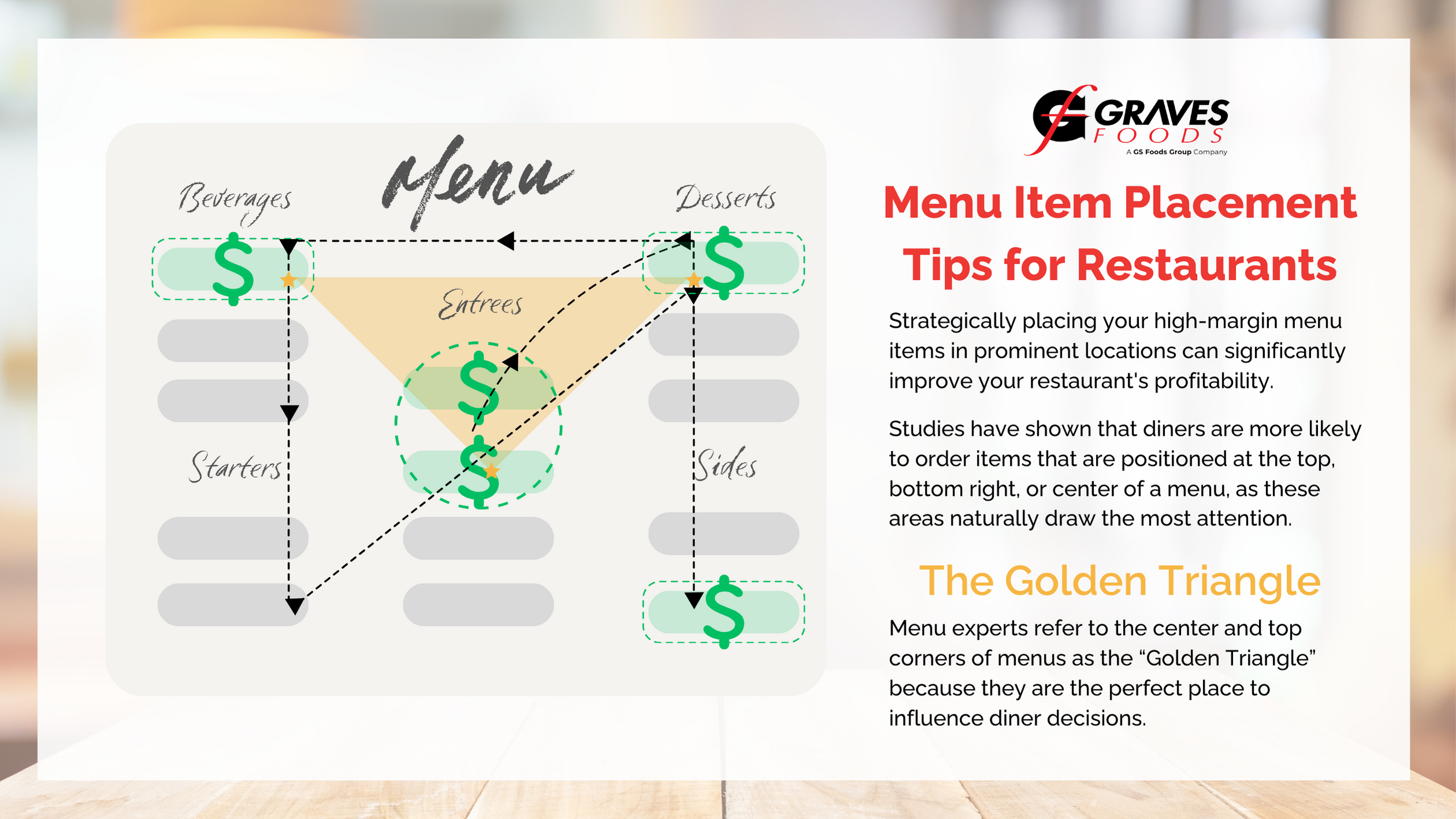In the fiercely competitive restaurant industry, having a well-designed menu can make all the difference. Your menu isn’t just a list of dishes; it’s a powerful tool that influences your diner’s overall experience, your kitchen, and your bottom line.
Whether you’re a seasoned restaurateur or launching your first eatery, here are five helpful tips for creating an appetizing restaurant menu design.
#1 Prioritize Menu Item Placement
When organizing your menu, make sure that you are strategically placing your high-margin menu items in prominent locations to significantly improve your restaurant’s profitability.
Studies have shown that diners are more likely to order items that are positioned at the top, bottom right, or center of a menu, as these areas naturally draw the most attention. Menu experts refer to the center and top corners of menus as the Golden Triangle because they are the perfect place to influence diner decisions.

By featuring your high-margin dishes in these prime locations, you can increase their visibility and likelihood of being ordered, ultimately driving up your restaurant’s revenue. Additionally, strategically placing these items near complementary or other popular dishes can further encourage upselling. By leveraging the psychology of menu design and strategically positioning your high-margin menu items, you can maximize profitability while providing an efficient ordering experience to customers.
Menu Psychology: The Golden Triangle

#2 Enhance Your Menu with Images
Incorporating images, logos, illustrations, or photography into menu design is crucial for engaging customers and enticing their appetites. Visual elements not only enhance the aesthetic appeal of the menu but also provide diners with a tantalizing preview of the dishes they can expect to enjoy.
Appetizing photographs of menu items can stimulate cravings and motivate diners to order while logos and illustrations can enhance your restaurant’s brand identity. Images and illustrations give your menu a touch of personality and professionalism while reinforcing brand recognition. Additionally, visual cues can aid in navigation and decision-making, guiding diners towards specific dishes or highlighting specials and promotions. Whether it’s a mouthwatering snapshot of a signature dish or a whimsical illustration that captures the essence of the restaurant, integrating visual elements into menu design is essential for creating a memorable and enticing dining experience.
#3 Punctuate Your Pricing
Punctuation plays a crucial role in menu design, particularly when it comes to displaying prices. Clear and consistent punctuation not only enhances readability but also helps manage customer expectations and avoids confusion. When listing prices, using a consistent format, such as placing the currency symbol at the beginning or end of the price and using decimals or commas to denote fractions, ensures uniformity across the menu.
Additionally, employing punctuation strategically can subtly influence perception; for example, removing the “$” symbol from higher-priced items can make them seem less expensive. Furthermore, using punctuation sparingly can help convey a sense of elegance and sophistication, aligning with the overall aesthetic of upscale dining establishments.
Ultimately, your punctuation strategy should appeal to the customers you serve and paying attention to the details in menu formatting can take a menu from good to great.

#4 Let the Eyes Eat First
When it comes to writing menu item descriptions, clarity and detail are key to ensuring that diners know exactly what they’re ordering.
Start by using descriptive language that vividly conveys the flavors, textures, and ingredients of each dish. Highlighting source of ingredients or your kitchen’s unique cooking techniques can provide valuable insight into the dish’s preparation. These details plus a hungry pair of eyes can help diners make well-informed menu choices.
With the recent rise of food allergies, consider including any relevant dietary information, such as whether a dish is spice level, gluten-free, vegan, or contains allergens like nuts or dairy. Use diner-friendly icons to convey dietary information and keep menu descriptions concise.
Avoid using overly flowery language, foreign language, or obscure terminology that may confuse diners. Ultimately, the goal is to paint a clear picture of each dish that leaves diners excited to try it.
#5 Make Your Menu Digital
In today’s digital age, having a menu that is accessible and user-friendly on mobile devices is not just a convenience—it’s a necessity. With everyone’s reliance on smartphones for reservation booking, providing a digital and mobile-friendly menu ensures that your restaurant can reach and attract a broader audience.
Using a digital menu software tool allows for easy updates like updating seasonal menu items, new specials, and pricing adjustments. Furthermore, a mobile-friendly menu enhances the overall dining experience by allowing customers to browse your current offerings conveniently from their devices, whether they’re at home, on-the-go, or already seated at your restaurant. By embracing digital technology and optimizing your menu for mobile devices, you can attract tech-savvy diners, improve customer satisfaction, and stay competitive in a rapidly evolving restaurant industry.
Make a Menu with Graves Foods
Designing a great restaurant menu is about more than just listing your dishes—it’s about creating an immersive and engaging experience that delights your customers and leaves them craving more.
By following the advice from the menu experts at Graves Foods, you can craft a menu that not only showcases your culinary offerings but also reinforces your restaurant’s unique identity and sets the stage for a truly unforgettable dining experience.
Need assistance from the menu pros at Graves Foods? Contact us and we’ll help you craft the perfect menu.
You might also be interested in ...
15 Apr 24
Advantages of Online Ordering for Your Restaurant
Advantages of Online Ordering for Your Restaurant In today’s fast-paced world, customer convenience will continue to reign supreme. Restaurants that offer online ordering are well on their way to meeting…
2 Apr 24
Maximizing Seasonal Menu Offerings: How Restaurant Owners Can Leverage Holidays While Menu Planning
For restaurant owners, seasonal changes bring shifts in weather and it can bring shifts in diner appetites. But you don’t have to blindly guess what diners want to eat when…
31 Jan 23
50,000 sq/ft Cold Storage Warehouse Expansion is now open!
MARCH CONSTRUCTION UPDATE: Loading Docs and Exterior Lighting 10 new loading docs are ready and equipped with automatic plates for easy loading and unloading, as well as our exterior lights…

